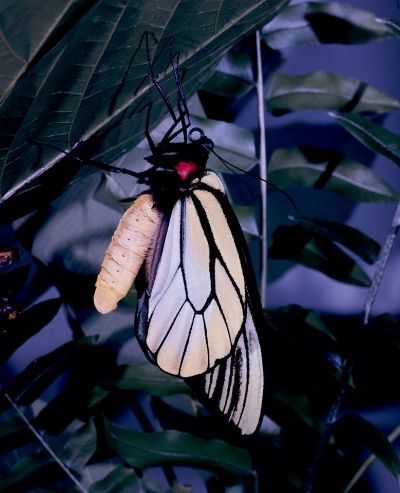|
|
Post by papalidar on Mar 11, 2013 16:26:54 GMT -8
My O P borchi (with size) Attachments:
|
|
|
|
|
|
Post by nomad on Mar 11, 2013 22:21:56 GMT -8
 Hi papalidar. Thank you for sharing your amazing O. paradisea borchi collection. This will help to work out the average size of this lovely butterfly. I expect in reality, there is not much size difference in borchi and the nominate race. I am in awe of the specimen in the center with magnificent 141mm wingspan. I would like to add, a very clear photograph of your borchi drawer, showing your specimens in very clear detail. Regards Peter.
|
|
|
|
Post by nomad on Mar 12, 2013 11:42:48 GMT -8
Wow what a specimen. Next to the nominate O. paradisea the rarest subspecies is O. paradisea flavescens and this amazing aberration was collected by Jan Pasternak near Lake Yamur in South Western New Guinea in 1978. This flavescens specimen is very similar to the male shown in this thread from the Weyland Mountains, and to that specimen of O. paradisea borchi taken by Harry Borch in the Torricelli Mtns, but has the very golden/green colour of the population from Lake Yamur. I believe this specimen went to Japan. I think this specimen would indeed break the bank balance. Many thanks to Jacques for sending me the photograph and to Jan Pasternak for his kind permission to show it here and which is his copyright. Peter. Attachments:
|
|
|
|
Post by simosg on Mar 12, 2013 12:02:37 GMT -8
I wonder about these aberration, all three specimens I have seen which look like this have been caught in the wild. As there must be more breeded specimens in collections that wild caughts, why are there no breeded specimens known to us with this aberration? Probably this aberration is triggered by terms which are more often in the wild than in breeding cages.
Hannes
|
|
|
|
Post by nomad on Mar 12, 2013 12:08:48 GMT -8
Very true Hannes.
All three specimens have been wild caught. These extreme aberrations are very rare and none seem to have been seen for many years
Peter.
|
|
|
|
Post by nomad on Mar 17, 2013 6:38:58 GMT -8
 As was mentioned in this thread, Harry Borch bred and captured many fine specimens of O. paradisea and O. goliath. I was pleased to have just acquired, this quite large O. paradisea borchi female [ex Henry Hensel collection] that was bred by Harry Borch [1976] from the Prince Alexander Mountain Range near Maprik, Northern New Guinea. This A1 specimen forms a nice pair with the also recently acquired male, which was also bred by Harry . Attachments:
|
|
|
|
|
|
Post by nomad on Oct 17, 2014 11:25:10 GMT -8
Two really nice photographs of freshly emerged O. alexandrae and O. paradisea taken by Harry Borch. The paradisea is probably borchi. Not only was Borch an expert field collector, he was an excellent photographer. Images courtesy of Marcin Gajewski from Warsaw -Poland. I enjoyed seeing these-thanks to Marcin  O. alexandrae male.  O. paradisea borchi? male.  |
|
|
|
Post by anthony on Oct 17, 2014 17:19:37 GMT -8
Another very informative and excellent post, thank you.
|
|
|
|
Post by marcingajewski on Oct 18, 2014 0:52:19 GMT -8
Two really nice photographs of freshly emerged O. alexandrae and O. paradisea taken by Harry Borch. The paradisea is probably borchi. Not only was Borch an expert field collector, he was an excellent photographer. Images courtesy of Marcin Gajewski from Warsaw -Poland. I enjoyed seeing these-thanks to Marcin  O. alexandrae male.  O. paradisea borchi? male.  My plesure Guys i will show more when i will find time to scan it ! |
|